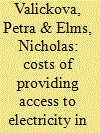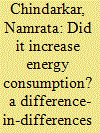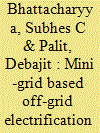|
|
|
Sort Order |
|
|
|
Items / Page
|
|
|
|
|
|
|
| Srl | Item |
| 1 |
ID:
175904


|
|
|
|
|
| Summary/Abstract |
Access to reliable energy is recognised as a key driver of human and economic development. Despite this, today only 45% of the population in Sub-Saharan Africa has access to electricity. Sustainable Development Goal number 7 calls for ensuring access to affordable, reliable, sustainable and modern energy for everyone. Yet, at the current rate of progress, less than 60% of the population in Sub-Saharan Africa will have access to electricity by 2030. In view of the urgent need to accelerate the rate at which electricity access is provided, we developed a detailed least-cost optimisation model to identify the incremental costs of providing access for the group of 12 countries in the Southern African Power Pool. Our analysis shows that achieving universal access by 2030 in the region, would lead to an incremental generation cost of between 5.2 and 11.4 US$2018 billion, depending on the consumption of newly connected households. This corresponds to an increase of system generation costs by 4–8% and the levelized incremental cost of supply to the customer of 108–116 US$2018 per megawatt hour. This is lower than what a typical household pays for poor alternatives to electricity, such as kerosene for lighting, implying that policy makers should accelerate access.
|
|
|
|
|
|
|
|
|
|
|
|
|
|
|
|
| 2 |
ID:
192806


|
|
|
|
|
| Summary/Abstract |
Electricity access is an important issue and building capacity for it requires drawing relevant lessons from past policies. In this study, we evaluate the effect of the Jyotigram Yojana, or the lighted village scheme, a supply-side policy intervention during 2003–08 to increase rural electricity access in Gujarat, India. We hypothesize that policy implementation is associated with increased electricity consumption. To test this hypothesis, we exploit variation in the timing of policy implementation at the village level, and use a generalized difference-in-differences strategy for identification. Further, we use night-time luminosity measured through remote sensing as a proxy for electricity consumption, and control for weather, village fixed effect, year fixed effect, and village or administrative block specific time trend. We find that while the overall effect of the policy on night-time luminosity was not statistically significant, the effects were likely heterogeneous, with the night-time luminosity increasing in some districts after policy implementation and decreasing in others. We conclude that the policy might have had a re-distributive effect on electricity access or consumption and recommend adopting a more holistic approach – incorporating both supply-side and demand-side measures – to increase electricity access.
|
|
|
|
|
|
|
|
|
|
|
|
|
|
|
|
| 3 |
ID:
179664


|
|
|
|
|
| Summary/Abstract |
The reported effects of electrification on rural entrepreneurship are mixed, with recent studies describing heterogeneity in outcomes and methodological challenges in attributing causal effects. Furthermore, the debate largely focuses on performance outcomes, rather than supply- and demand-side barriers to productive electricity use itself. In this paper, we contribute new evidence describing electricity use among micro- and small-enterprises (MSEs) in rural northern India. Puzzlingly, 34% of the 2,004 MSEs surveyed have no grid-connection despite almost complete village grid electrification. We exploit variation in grid supply hours at village level, finding no conclusive link with this and MSE connection likelihoods. Rather, connection likelihood appears to be more closely related to wealth characteristics. Supporting this hypothesis, the reported electricity consumption appears equally unrelated to supply quality and quite low overall: 75% of grid-connected MSEs consume less than 1 kW-hour per day, powering only lighting and fans. These results are notable given the positive bias we expect due to the likely endogeneity between grid supply quality and broader development trends, as noted in recent literature. Our work follows others in arguing that supply side improvements must occur in concert with demand side initiatives to unlock rural MSE electricity consumption. At the same time, the role of off-grid technologies in meeting nascent MSE electricity needs deserves further study.
|
|
|
|
|
|
|
|
|
|
|
|
|
|
|
|
| 4 |
ID:
098604


|
|
|
|
|
| Publication |
2010.
|
| Summary/Abstract |
A lack of access to energy and, in particular, electricity is a less obvious manifestation of poverty but arguably one of the most important. This paper investigates the extent to which electricity access can be investigated using night-time light satellite data and spatially explicit population datasets to compare electricity access between 1990 and 2000. We present here the first satellite derived estimates of rural population without access to electricity in developing countries to draw insights on issues surrounding the delivery of electricity to populations in rural areas. The paper provides additional evidence of the slow progress in expansion of energy access to households in Sub-Saharan Africa and shows how this might be ascribed in part due to the low population densities in rural areas. The fact that this is a continent with some of the lowest per-capita income levels aggravates the intrinsic difficulties associated with making the investments needed to supply electricity in areas with low population density and high dispersion. Clearly, these spatial dimensions of the distributions of the remaining unelectrified populations in the world have an impact on what options are considered the most appropriate in expanding access to these households and the relative attractiveness of decentralized options.
|
|
|
|
|
|
|
|
|
|
|
|
|
|
|
|
| 5 |
ID:
175029


|
|
|
|
|
| Summary/Abstract |
Premised on our contention about the narrowness of the contemporary, industry-centric, focus to understanding the causes for the underdeveloped state of electricity industry in PNG, this paper develops a governance perspective for facilitating such an understanding. The analytical framework employed for this purpose is informed by core tenets of the state-society relational theory. The analysis undertaken in this paper suggests that the development of electricity industry in PNG has been ad hoc in nature, typified by the prevalence of piecemeal efforts for redressing electricity issues of the time. Further, this ad hoc development is essentially reflective of the underlying crisis of governability, as indicated by persistent political instability and frequent changes of government. This crisis has arisen from the ubiquity of conflicts, at the local level, between the western-style formal governance framework adopted after independence, and the culturally-attuned informal governance framework that has existed in the local communities for centuries. In such environments, the government tends to focus on redressing the immediate threat of political survival. The question of long-term development of the country (including, electricity industry development) has therefore assumed a dormant role. Outcome is the persistence of underdevelopment of the electricity industry.
|
|
|
|
|
|
|
|
|
|
|
|
|
|
|
|
| 6 |
ID:
171403


|
|
|
|
|
| Summary/Abstract |
Using survey data from the Afrobarometer, we document that respondents who live in areas where more people report having paid a bribe to access household services are more likely to have access to electricity. The existing literature suggests three mechanisms that could explain why more corruption increases access to electricity. Corruption could incentivize firms to operate in the shadow economy and facilitate them doing so. Corruption could reduce enforcement of the law for electricity theft. Finally, corruption could lower firms’ costs by allowing them to reduce the burden of red tape and or ignore standards. The data do not support the first two of these mechanisms suggesting that corruption is “greasing the wheels” for firms in the electricity sector. Supporting this conclusion is the fact that this relationship between corruption and access is only statistically significant in countries where the ease of getting electricity is low and there is private participation in the electricity sector.
|
|
|
|
|
|
|
|
|
|
|
|
|
|
|
|
| 7 |
ID:
179702


|
|
|
|
|
| Summary/Abstract |
As household electrification rates continue to increase globally, the focus in energy access planning is increasingly shifting towards quality of service. To inform this planning, we explore changes in household electricity and people's use and satisfaction with their service over time in rural India. Fielded in 2015, the ACCESS survey collected data on energy access from more than 8,500 households living across six Indian states. In 2018, the same households were re-surveyed. Using this longitudinal dataset, we sketch the changes in electricity access that took place during these three years. We find that access and the quality of supply have both improved substantially, with a 17 percentage points increase in electrification rates (95% CI: [15,19]). However, a large minority (about one fifth) remains unsatisfied with its electricity access. People's satisfaction levels were more sensitive to the quality of supply in 2018 compared to 2015. We propose that this change is a result of evolving expectations of electricity services that are offered. As households climb electricity access tiers and acquire more and larger electric appliances (such as fans or TVs), their demands increasingly shift from focusing on the extensive margin of supply to its intensive margin.
|
|
|
|
|
|
|
|
|
|
|
|
|
|
|
|
| 8 |
ID:
150658


|
|
|
|
|
| Summary/Abstract |
With 1.2 billion people still lacking electricity access by 2013, electricity access remains a major global challenge. Although mini-grid based electrification has received attention in recent times, their full exploitation requires policy support covering a range of areas. Distilling the experience from a five year research project, OASYS South Asia, this paper presents the summary of research findings and shares the experience from four demonstration activities. It suggests that cost-effective universal electricity service remains a challenge and reaching the universal electrification target by 2030 will remain a challenge for the less developed countries. The financial, organisational and governance weaknesses hinder successful implementation of projects in many countries. The paper then provides 10 policy recommendations to promote mini-grids as a complementary route to grid extension to promote electricity access for successful outcomes.
|
|
|
|
|
|
|
|
|
|
|
|
|
|
|
|
| 9 |
ID:
171400


|
|
|
|
|
| Summary/Abstract |
Universal household electrification is a key component of the United Nations Sustainable Development Goals, but the evidence base for social and economic impacts of electricity access remains unclear. Here we report results from a systematic review of impact evaluations of household electrification based on five key outcome measures. We only find 31 studies that conduct statistical hypothesis tests to assess impacts. Among these, seven draw on a randomized experiment designed for causal inference. The randomized experimental studies generate fewer positive results than observational or quasi-experimental studies, such as correlational, instrumental variable, and difference-in-differences designs. These results call for a reassessment of what we know about the impacts of household electrification. They also call for major investment in impact evaluation of electricity access using randomized controlled trials, with a particular focus on when and how energy access interventions can furnish large benefits to their intended beneficiaries. Large-scale impact evaluations using experimental methods will require close collaboration between policymakers and researchers.
|
|
|
|
|
|
|
|
|
|
|
|
|
|
|
|
| 10 |
ID:
166932


|
|
|
|
|
| Summary/Abstract |
In India, 46 million, mostly rural, households lack access to electricity – over 50% of those are in the states of Bihar and Uttar Pradesh. While India has set an aggressive goal of extending the grid to all households by 2019, grid extension does not necessarily imply reliable electricity access. Indian utilities face a financial disincentive to supplying reliable electricity in rural areas because of subsidized tariffs and low consumer willingness-to-pay. Tariff subsidies for full household electrification in these states would be about Rs 15,000 Cr per year, which is two-times the existing subsidies and equivalent to 20–30% of their annual utility revenues. We find that super-efficient lamps, TVs, and fans can reduce the energy consumption of a rural household by over 70% cost-effectively, resulting in a net reduction in the total subsidy burden. Reduced consumption offers an opportunity to raise consumer tariffs while ensuring consumers’ monthly electricity bills reduced. We also argue that super-efficient appliances make consumer-side storage cost-effective, leading to greater consumer willingness-to-pay. We recommend adoption of super-efficient appliances as part of the electricity access initiative in India, and electricity service based tariff setting as the next policy steps towards providing a reliable and sustainable electricity access.
|
|
|
|
|
|
|
|
|
|
|
|
|
|
|
|
| 11 |
ID:
188557


|
|
|
|
|
| Summary/Abstract |
Off-grid electricity systems have burgeoned across Africa recently, extending electricity access to rural communities. With the accelerated adoption of mini-grids and solar home systems, it is becoming increasingly important to understand how their customer bases consume and spend on electricity. Using a novel data set of hourly electricity consumption and electricity expenditures of about 13,000 solar home system customers in Kenya in 2018 and 2,000 mini-grid customers in Tanzania in 2017, we present a relative examination of the electricity consumption behavior and spending patterns among mini-grid and solar home system customers. Our analysis shows that, on average, mini-grid customers spend substantially less on electricity than solar home system customers and make smaller, more frequent payments during the month. We also find that higher monthly spending among mini-grid customers correlates with off-peak consumption and a higher load factor, contrary to the behavior of solar home system customers. Our results suggest the need for policies that encourage the growth of productive uses of energy that are innovative, diverse, and daytime-oriented to ensure sustainable mini-grid operation, as well as policies that establish a larger market for solar home system-compatible electric appliances that incentivize solar home system customers to increase utilization of their systems.
|
|
|
|
|
|
|
|
|
|
|
|
|
|
|
|
| 12 |
ID:
176681


|
|
|
|
|
| Summary/Abstract |
Since the 1990s, many developing countries have restructured their electric power industry. Policies such as breaking up, commercializing and privatizing utilities, allowing for independent power producers, installing independent regulators, and introducing competitive wholesale markets were meant to improve the industry's efficiency and service quality. We exploit more than 30 years of data from over 100 countries to investigate the impact of power sector reforms on efficiency (represented by network losses) and access to electricity (represented by connection rates and residential power consumption). Crucially, reforms are likely to be endogenous with respect to sector performance: a crisis in electricity supply might well trigger reform efforts. We deal with endogeneity using reform activity in neighboring countries as an instrument. Our results suggest that reforms strongly and positively impact electricity access. According to our preferred specification, a full reform program would increase connection rates by 20 percentage points and per capita consumption by 62 percent: these are large effects that are stable across a range of robustness checks. Moreover, the effect of improving access is largest in South Asian countries. In contrast to previous studies, we do not find robust evidence to support the theory that reforms reduce network losses.
|
|
|
|
|
|
|
|
|
|
|
|
|
|
|
|
| 13 |
ID:
114319


|
|
|
|
|
| Publication |
2012.
|
| Summary/Abstract |
This study is motivated by the goal of achieving 'Universal Energy Access' by 2030 and looks at electricity access for rural households in the South Asian region. The 'MESSAGE-Access' model is employed to assess the cost effectiveness of centralized and Decentralized Distributed Generation (DDG) technologies. Delivery mechanisms are modelled to include mini-grid and stand-alone systems and the analysis includes an estimation of rural household electricity demand from lighting and appliances. We assume two future demand scenarios with a 'minimum threshold' and a 'higher threshold' of electricity consumption of 65 and 420 kW h per household per year, respectively. We find that the cost of delivering electricity by centralized generation and grid distribution is up to four times the cost of stand-alone and mini-grid DDG options in the case of 'minimum threshold' demand scenario. These results are robust to alternate assumptions regarding costs of technologies. We also estimate that public subsidy bill for kerosene can be substantially reduced if all households switch to electricity as their primary source of lighting. Thus, promoting DDG options can reduce capital investments needed to meet access goals significantly and have an important role to play, in meeting the goal of universal electrification by 2030.
|
|
|
|
|
|
|
|
|
|
|
|
|
|
|
|
| 14 |
ID:
167031


|
|
|
|
|
| Summary/Abstract |
Access to electricity continues to be a popular subject in empirical studies. However, the choice of key factors related to electricity access in the literature to date has been ad hoc due to the lack of a theoretical framework. This paper adopts a Bayesian Model Averaging (BMA) approach to selects important factors related to electricity access from 26 socioeconomic indicators using a sample of 48 developing countries, and reveal their long-term relationship with electricity access. The BMA approach allows us to identify the optimal empirical model when a theoretical foundation is not available. Moreover, it allows us to address the relative importance of variables using posterior inclusion probabilities and thus has clear policy relevance. Our results show that access to finance, education, economic development, infrastructure, and industrialisation are positively related to electricity access in the long-run. Although the long-run relationship does not indicate causality, it shows that to maintain this relationship, policy adjustments against any deviations from the relationship are needed. Our study suggests that electrification needs not only economic, educational and infrastructural development, but also private sector participation, governments’ commitment and political will, and integration with poverty reduction and other development schemes.
|
|
|
|
|
|
|
|
|
|
|
|
|
|
|
|
|
|
|
|
|